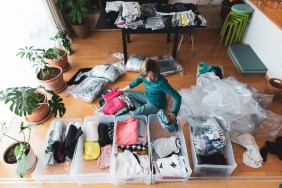Reebok’s head of advanced innovation, Bill McInnis
- Know the difference between a shoe that’s designed for gym classes versus a running shoe. A shoe designed for the gym focuses more on lateral movement and traction vs. a running shoe that tends to have a little higher midsole height. The additional height is to accommodate the additional cushioning typically required in a traditional (non–barefoot) style of running shoe.
- When it comes to wearing a shoe that is activity-specific, it’s probably less a case of whether it’s a “necessary” thing and more a question of how do you optimize an activity by using a shoe specifically designed for it. Outside the gym, for example, you could play football or basketball wearing running shoes, but you wouldn’t be as effective. The same holds true in the gym.
- Running shoes are typically designed for distance or endurance running. If distance running (2-3 miles or more) is a focus of your training, I’d recommend sticking with running shoes. If, however, the bulk of your training time is spent in the gym, you should probably look for a shoe with a little more support, like a cross trainer.
- If you spend most of your time on the machines at the gym (and I’m excluding treadmills here as running shoes are most appropriate), you want to focus on flexibility as you want your foot to stay active to avoid that numb or tingling sensation you can experience on machines. You also want to focus on a good fitting upper, particularly one that doesn’t bind too tight in the lace area as that can contribute to numbness as well. From our range, either of our RealFlex shoes would be good choices.
- If you spend most of your time taking classes at the gym, then I think you’d want a versatile lower profile shoe with flexibility, traction, and lateral support. Again, I think from our range, the RealFlex Transition is a good example of a versatile shoe for a variety of classes.
Fitness expert and celebrity personal trainer, Kira Stokes
image: kirastokes.com- Always buy your shoes 1/2 to 1 full size bigger than your “dress shoes.” You need room for your toes to push forward during exercise. This will avoid the dreaded “black toe.”
-
Running shoes can be used for more than just running. I encourage clients/students to go for runners versus cross-trainers even for my bootcamp style class Stoked 360. Often times cross-trainers are too rigid and although they provide more lateral support, do not allow the foot and ankle to strengthen as they should for various activities. They become almost a “crutch.” This, of course, applies to those who are injury free, without special needs.
-
Know your gait or foot placement — i.e. do you pronate (foot rolls in), supinate (foot rolls out), or have a neutral gait? Go to a store that has experts who will watch you run or walk on a treadmill to determine your needs with regards to extra support within your shoes. For example, if you pronate, you will need a shoe with a footbridge in the interior portion to help prevent the foot from rolling in. This is often times visible with a different color than the rest of the shoe. If you go to a store without such experts, check the soles of your current shoes to see where the tread is most worn. If the inside of the tread is worn, you most likely need a shoe to correct pronation. If the outside portion is worn, you most likely need a shoe to correct supination. If the tread seems evenly worn, go for a shoe marked neutral.
-
Obviously, fit and function comes first, but if you can find a shoe that accommodates your needs AND looks amazing, go for the cool factor! If you love the look of your sneakers, you will be much more motivated to put them on and kick your exercise routine into high gear. I find bright colored sneakers truly evoke more energy and put you in a better mood. Nothing better than burning calories with a smile on your face!
Director of coaching for AA Elite Coaching, Andrew Allden
- Go to a running shoe or running specialty store, not a department or general sporting goods store as they will usually allow you to take a test run.
- Size matters, fit is the number one issue. The biggest mistake most folks make is wrong size — generally too small (this is particularly true for women). You can’t go by what you normally wear even if you have worn running shoes previously or even that make or brand. Running shoes are more true to size than they used to be, but don’t get stuck on a number, go by the fit.
- Don’t skimp on socks. Don’t get $100 shoes and $1 socks and then wonder why you get blisters. To that end – always wear socks when you run, this will increase the life of the shoe, particularly if you are a heavy sweater. [ed note: Opt for moisture wicking socks.]
- If it works, don’t fix it. If you have a shoe model that has worked for you, don’t do the iPhone/iPad upsell to the latest model.
- Go shopping at the end of the day when your feet are at their biggest.
- Break shoes in gradually. Don’t wear new shoes in a race or on a long run until they have been used on several shorter runs.
- Minimalist or barefoot type shoes are not for everyone. Just because you know one person who raves about them does not mean you should make that change.
New Balance Pro tips
- Always wear the type of socks you intend to exercise in when trying on athletic footwear, thus ensuring a proper fit for your workout.
- Have the salesperson measure your foot — length and width — for both feet.
- In order to see if the shoe fits, do a “thumb test.” You need about a thumbnail’s width between your longest toe and the end of your shoe. You should also be able to wiggle your toes freely inside the shoes.
- Try on both shoes of the pair — don’t necessarily assume that both feet are the same size or that since one shoe fits, they both will. [ed note: If one foot is larger than the other, purchase your shoes according to the larger size and put in an insole.]
- Take them for a test drive. Many stores let you take a test jog/walk around the block before buying. Walk, run, and jump in the shoes to make sure they are comfortable when doing multiple activities.
Now that you’re better informed as to what to look for, here’s a look at some of the latest high-performance sneaker styles worth trying on, some of which have been referenced above.
Sneaker Shopping
-
Reebok

RealFlex Transition, $99.98
-
Reebok

CrossFit Flex Nano, $119.99
-
Reebok

ZigNano Fuse Train II, $109.98
-
Adidas

ClimaCool Seduction, $100
-
New Balance

997, $89.98
-
New Balance

890, $99.99
-
Nike

Free 2 Breather, $99.99
-
Nike

Livestrong Air Max 2012, $175
-
Newton Running









